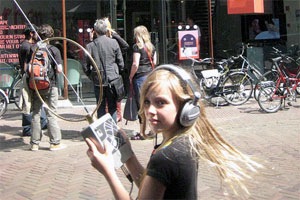After a bit of a long summer break Alexander, Ianus and I are back with another edition of This happened – Utrecht. Read about the program of the seventh edition below. We’ll add a fourth speaker to the roster soon. The event is scheduled for Monday 4 October at Theater Kikker in Utrecht. Doors open at 7:30PM. The registration opens next week on Monday 20 September at 12:00PM.

Anne Nigten is director of The Patchingzone, a transdisciplinary laboratory for innovation where Master, doctor, post-doc students and professionals from different backgrounds create meaningful content. Earlier, Anne Nigten was manager of V2_lab and completed a PhD on a method for creative research and development. Go-for-IT! is a city game created together with citizens of South Rotterdam and launched in December 2009. On four playgrounds in the area street tiles were equipped with LEDs. Locals could play games with their feet, similar to console game dance mats.

Richard Boeser is an independent designer based in Rotterdam. His studio Sparpweed is currently working on the game Ibb and Obb, scheduled to launch for Playstation Network and PC in August 2011. Ibb and Obb is a cooperative game for two players who together must find a way through a world where gravity is flipped across the horizon. Players move between both sides of the world through portals. They can surf on gravity, soulhop enemies and collect diamonds. The game is partly financed by the Game Fund, an arrangement that seeks to stimulate the development of artistic games in the Netherlands.

Edwin van der Heide studied sonology at the Royal Conservatory in The Hague. He now works as an artist in the field of sound, space and interaction. Radioscape transforms urban space into an acoustic labyrinth. Based on the fundamental principles of radio each participant is equipped with a receiver, headphones and an antenna. Fifteen transmitters each broadcast their own composition. Inspired by short wave sounds, they overlap to form a metacomposition. By changing position, the interpretation of sound is changed as well.
A big thank you to our sponsors, Microsoft and Fier for making this one happen.









